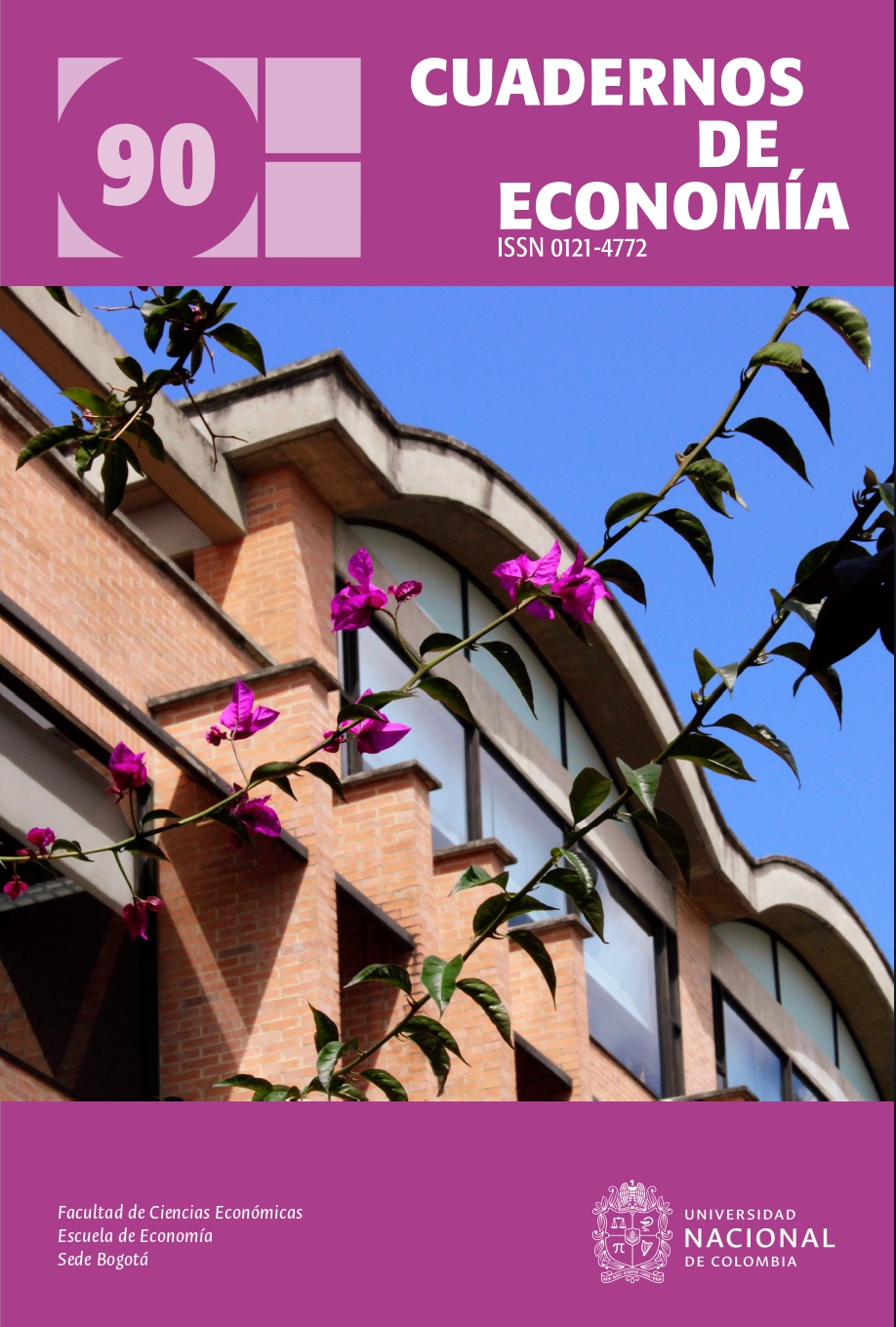The peruvian mining boom and dutch disease. Empirical evidence from 2003 to 2020
El boom minero peruano y la enfermedad holandesa. Evidencia empírica del 2003 al 2020.
DOI:
https://doi.org/10.15446/cuad.econ.v42n90.94529Palabras clave:
Dutch disease, VARX estimation, Mineral price boom, Peru (en)Enfermedad holandesa, Estimación VARX, Auge de precio de los minerales, Perú (es)
Descargas
The aim of this paper is to verify whether Peru has suffered from Dutch disease. To do this, a VARX model with monthly data from 2003 to 2020 is used to analyze whether the mining boom prices of the 2000s and 2010s have had a negative impact on the real sector, especially on non-primary manufacturing. Results show that a real exchange rate shock explains 8.2% of the variation in non-primary manufacturing. Even though the effect is significant, it is relatively small, and this is due to the Peruvian Central Bank intervening to reduce exchange rate volatility
El objetivo de este artículo es verificar si Perú ha sufrido una enfermedad holandesa. Para ello se utiliza un modelo VARX con datos mensuales de 2003 a 2020 para analizar si el boom minero de las últimas dos décadas ha tenido un efecto negativo en el sector real, especialmente en manufactura no primaria. Los resultados muestran que un shock de tipo de cambio real explica el 8,2 % de la variación en la manufactura no primaria. Aunque existe un efecto significativo, este es pequeño, y esto debido a que el Banco Central de Perú interviene reduciendo la volatilidad del tipo de cambio.
Referencias
Abdlaziz, R., Naseem, N., & Slesman, L. (2018). Dutch disease effect of oil price on agriculture sector: Evidence from panel cointegration of oil exporting countries. International Journal of Energy Economics and Policy, 8(5), 241-250. https://www.econjournals.com/index.php/ijeep/article/view/6723
Alarco, G. (2011). Exportaciones, tipo de cambio y enfermedad holandesa: el caso peruano. Investigación Económica, 70(275), 115-143. http://dx.doi.org/10.22201/fe.01851667p.2011.275.24265
Bjornland, H. (2003). The economic effects of North Sea oil on the manufacturing sector. Scottish Journal of Political Economy, 45(5), 553-585. https://doi.org/10.1111/1467-9485.00112
Brahmbhatt, M., Canuto, O., & Vostroknutova, E. (2010). Dealing with Dutch disease. The World Bank economic premise. http://hdl.handle.net/10986/10174
Bruno, M., & Sachs, J. (1982). Energy and resource allocation: A dynamic model of the Dutch disease. Review of Economic Studies, 8(52), 1-38. http://doi.org/10.3386/w0852
Buiter, W., & Purvis, D. (1980). Oil, disinflation, and export competitiveness: A model of the Dutch disease [Working Paper N° 592]. National Bureau of Economic Research. http://doi.org/10.3386/w0592
Canova, F. (1999). Vector autoregressive models: Specification, estimation, inference and forecasting. In H. Pesaran & P. Schmidt (Eds.), Handbooks of Applied Econometrics (1st ed., pp. 53-110). Blackwell Publishers. https://doi.org/10.1111/b.9780631215585.1999.00003.x
Corden, W., & Neary, J. (1982). Booming sector and de-industrialization in a small open economy. The Economic Journal, 92(368), 825-848. https://doi.org/10.2307/2232670
Cruz, S. (2011). The resource curse and Peru: A potential threat for the future? [Unpublished master’s thesis, University of San Francisco]. https://repository.usfca.edu/thes/4
Desfrancois, P. (2019). Evaluación empírica de los síntomas de la enfermedad holandesa en la historia ecuatoriana reciente (2007-2017). Actualidad Económica 29(97), 23-35. https://revistas.unc.edu.ar/index.php/acteconomica/article/view/24270
Enders, W. (2015). Applied econometric time series (4th Edition). Wiley.
Gylfason, T. (2001). Lessons from the Dutch disease: Causes, treatment, and cures [Working Paper Series No. 1(06)]. Institute of Economics Studies. https://www.researchgate.net/publication/277227867_Lessons_from_the_Dutch_disease_Causes_treatment_and_cures
Hiroyuki, T., & Lar, N. (2015). Global value chains participation and industrial upgrading in Asian developing economies [MPRA Paper No. 65708]. Munich Personal RePEc Archive. https://mpra.ub.uni-muenchen.de/65708/1/MPRA_paper_65708.pdf
Ito, K. (2019). Remittances and the Dutch disease: Evidence from Georgia. Post-Communist Economies, 31(4), 500-506. https://doi.org/10.1080/14631377.2018.1537733
Kilian, L., & Zhou, X. (2018). Modeling fluctuations in the global demand for commodities. Journal of International Money and Finance, 88, 54-78. https://doi.org/10.1016/j.jimonfin.2018.07.001
Koitsiwe, K. & Adachi, T. (2015). Australia mining boom and Dutch disease: Analyzing using VAR method. Procedia Economics and Finance, 30, 401-408. https://doi.org/10.1016/S22125671(15)01307-6
Landa, Y. (2020). Industrial policies of countries with abundant natural resources in the Association of Southeast Asian Nations and Pacific Alliance. The Extractive Industries and Society, 7(3), 1046-1053. https://doi.org/10.1016/j.exis.2020.07.004
Lanteri, L. (2015). Efectos de la enfermedad holandesa. Alguna evidencia para América Latina. Revista de Economía del Rosario, 18(2), 187-209. https://doi.org/10.12804/rev.econ.rosario.18.02.2015.02
López, M., Torres, E., & Giraldo S. (2016). The evolution of Colombian industry in the context of the energy-mining boom: Symptoms of the Dutch disease? Cuadernos de Economía, 35(68), 475-490. https://doi.org/10.15446/cuad.econ.v35n68.54255
Oomes, N., & Kalcheva, K. (2007). Diagnosing Dutch disease: Does Russia have the symptoms? [Working Paper No. 7/2007]. BOFIT. https://doi.org/10.2139/ssrn.1001659
Orihuela, J., & Gamarra, V. (2018). Variegated dependence: The geographically differentiated economic outcomes of resource-based development in Peru, 2001–2015 [Working Paper No. 458]. PUCP. http://doi.org/10.18800/2079-8474.0458
Rudd, D. (1996). An empirical analysis of Dutch disease: Developing and developed countries. Honors Projects, 62. https://digitalcommons.iwu.edu/econ_honproj/62/
Sarmiento, E., & López, M. (2016). Incidencia del tipo de cambio sobre la enfermedad holandesa de las ganancias de los bienes transables y no transables. Centros de Estudios Monetarios Latinoamericanos, (1), 45-81. https://www.cemla.org/PDF/monetaria/PUB_MON_XXXVIII-01-02.pdf
Vega. G. (2014). Enfermedad Holandesa y política fiscal en el Perú: un enfoque estructural de equilibrio general dinámico [Unpublished undergraduate thesis, Universidad de Piura]. https://hdl.handle.net/11042/1977
Whittembury, A. M. (2012). Is the Peruvian economy suffering from Dutch disease? Revista de Temas Financieros, 8(1). https://www.sbs.gob.pe/Portals/0/jer/rebper_2012_vol_vi/20150914_Whittembury.pdf
Wong, S., & Petreski, M. (2014). Dutch disease in Latin American countries: De-industrialization, how it happens, crisis, and the role of China [Working Paper No. 57056]. Munich Personal Repec Archive. https://ideas.repec.org/p/pra/mprapa/57056.html
Cómo citar
APA
ACM
ACS
ABNT
Chicago
Harvard
IEEE
MLA
Turabian
Vancouver
Descargar cita
Licencia
Derechos de autor 2023 Cuadernos de Economía

Esta obra está bajo una licencia internacional Creative Commons Atribución-NoComercial-SinDerivadas 4.0.
Cuadernos de Economía a través de la División de Bibliotecas de la Universidad Nacional de Colombia promueve y garantiza el acceso abierto de todos sus contenidos. Los artículos publicados por la revista se encuentran disponibles globalmente con acceso abierto y licenciados bajo los términos de Creative Commons Atribución-No_Comercial-Sin_Derivadas 4.0 Internacional (CC BY-NC-ND 4.0), lo que implica lo siguiente:




















